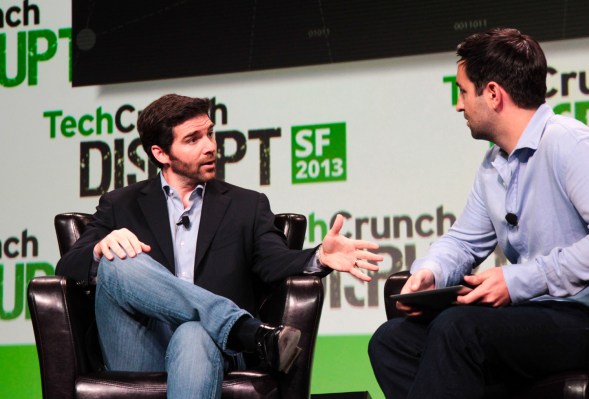The market capitalization of LinkedIn ($32.6 billion) has now passed that of Salesforce ($29 billion), but as Salesforce makes increasing moves into social media, and LinkedIn makes more moves into services to help people do their jobs, LinkedIn’s CEO played down the idea that the two are potential competitors — for now, at least. In the meantime, as the company continues to grow, it’s eyeing up how others like Google may crowd into its space.
“Salesforce is a partner today,” CEO Jeff Weiner said in an interview at TC Disrupt, with the cloud services company using LinkedIn’s APIs for services to help salespeople convert “their network contacts from cold calls into actual prospects.” It’s one of 100,000 developer partners that LinkedIn works with today, Weiner said.
At the same time, he’s mindful that the company, now pushing 250 million users globally, needs to keep moving ahead with how it evolves as a business, particularly since companies like Google could very easily move into more professional profiles and begin to eat LinkedIn’s lunch. On the subject of how Google+, the search engine giant’s own social network, might at some point try to convert this network to be aimed more closely at professional profiles (and link that up with job listings and job searches), Weiner said this: “We’re going to stay focused on a professional context, but we’re going to keep an eye out,” he said. “If there are search engines out there who decided to get more professionally focused that could introduce a new dynamic.”
Internally, LinkedIn is putting more resources into developing more enterprise services — for example, he described what sounded a lot like a Yammer-style service to “get more value from its platform.” But for now they are using these tools internally with “no definitive plans” for turning them into products, Weiner noted. But watch this space:
“It’s important there to draw the distinction between what has historically been a public, professional network — which is what LinkedIn is where most of the content shared on LinkedIn is publicly available …and a private professional network, which is what you’re going to increasingly see in the enterprise,” he explained.
“We would then be in the position, by virtue of our platform, to think about productizing that,” said Weiner.
Asked by panel moderator, TechCrunch co-editor Eric Eldon, if the private version of the LinkedIn business networking service would be like others in this space, such as Microsoft-owned Yammer or Salesforce’s Chatter, Weiner said that they would want it to be “specific and unique,” versus the competitive landscape that currently exists. The private version of LinkedIn would focus more on things like professional identity, for example.
LinkedIn, which started out as a place where people could connect with other professionals, quickly evolved into a place that became best known as a place where people went to look for jobs, or tap people for job vacancies.
LinkedIn has most definitely been building out that profile of itself — for example by enhancing its online resume services, most recently making them mobile-friendly, and getting more active in mobile in general. But with declining revenue growth one of its bigger issues, LinkedIn has also been looking for ways to grow the rest of its business as a repository of all kinds of business information to help people do their jobs better. One key area, for example, has been its content business, bolstered by acquisitions like Pulse and the push it has made with its “Influencer” network, with public figures like Richard Branson (now with over 2 million followers on LinkedIn) imparting words of management and business wisdom.
Weiner avoided questions today about whether it might use this to position itself as more of a publisher in its own right, but again didn’t rule this out. “One of our primary objectives is to go where our customers are going,” he said. Last week, the company announced that it would be raising over $1 billion in a public offering to use in areas like acquisitions and international expansion. It will be worth seeing whether that takes LinkedIn into scaling operations — buying assets that enhance what it does already — or strategic moves to add new business areas altogether.
“Our longer term vision is to develop the world’s first economic graph and mapping the world’s economy,” Weiner said a variation of Facebook’s ambition to be the Internet’s social graph. “Increasingly jobs are fragmented so it’s not just about jobs,” he said. “The people in jobs need to have the right access to information.”
Backstage Interview
